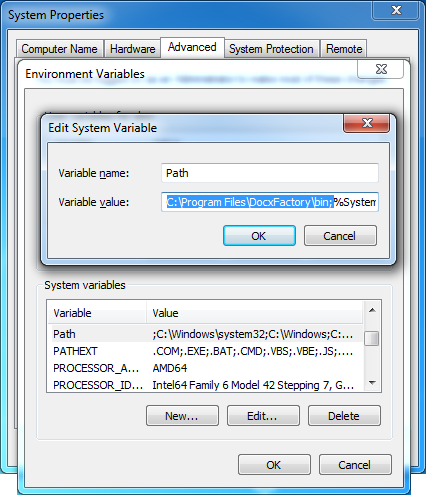Windows Installation
This chapter shows you how to install and setup DocxFactory on Windows.
Go to www.docxfactory.com and download the Windows installation .ZIP file.
For the Windows 32bit version download DocxFactoryWin32.zip.
For the Windows 64bit version download DocxFactoryWin64.zip.
Extract the DocxFactory\ directory into the Program Files\ directory.
The DocxFactoryWin32.zip is extracted to the C:\Program Files (x86)\ directory.
The DocxFactoryWin64.zip is extracted to the C:\Program Files\ directory.
Note: If there is an older version installed then delete the DocxFactory directory first (do not overwrite it). You may need to shutdown all processes using the DocxFactory.dll or the file will be locked and undeletable.
Add the DocxFactory\bin\ directory to the Windows PATH used to search for executables and libraries when a program is run.
Right click My Computer and click Properties.
In the System Properties window, click on the Advanced tab.
In the Advanced section, click the Environment Variables button.
In the Environment Variables dialog box, select the PATH variable in the Systems Variable section, click the Edit button and add to the PATH the “C:\Program Files\DocxFactory\bin;” directory with a semicolon to separate it from the other directories (see picture below).

Note: You will need to restart all processes that use the DocxFactory.dll (or simply restart the Computer) for the changes in the PATH environment variable to take effect.
Install the DocxFactory Python module.
Open the Command Prompt and enter the commands below.
C:> cd "C:\Program Files\DocxFactory\python" C:> python setup.py install |
Note: The python-devel package (for the Python version you are using) must be installed to compile the extension module (which is the default on Windows installation). If the Python.h file exists in the Python installation include directory then the python-devel package is most likely installed.
Note: You will need a C++ compiler to compile the extension module (.pyd file) for the Python version you are using. If you do not have a compiler installed, you can install Microsoft Visual C++ Express.
Note: You can also create a binary distribution (using distutils) for the same Python version with the compiled extension module that can be used to install the extension module without a compiler or the python-devel package.